Μorphometric Analysis for the Assessment of Relative Tectonic Activity in Evia Island, Greece
Abstract
1. Introduction
2. Study Area
3. Materials and Methods
3.1. Data Collection
3.2. Geomorphic Indices
3.2.1. Drainage Basin Slope (Sb)
3.2.2. Hypsometric Integral (Hi)
3.2.3. Asymmetry Factor (Af)
3.2.4. Relief Ratio (Rh)
3.2.5. Melton’s Ruggedness Number (M)
3.2.6. Index of Relative Tectonic Activity (Irta)
4. Results
4.1. Morphometric Analysis
4.1.1. Drainage Basin Slope (Sb)
4.1.2. Hypsometric Integral (Hi)
4.1.3. Asymmetry Factor (Af)
4.1.4. Relief Ratio (Rh)
4.1.5. Melton’s Ruggedness Number (M)
4.1.6. Index of Relative Tectonic Activity (Irta)
4.2. The Role of Bedrock Lithology and Surface Deposits
5. Discussion
6. Conclusions
Author Contributions
Funding
Acknowledgments
Conflicts of Interest
References
- Burbank, D.W.; Anderson, R.S. Tectonic Geomorphology, 2nd ed.; Wiley-Blackwell: Hoboken, NJ, USA, 2012; p. 460. [Google Scholar]
- Keller, E.A.; Pinter, N. Active Tectonics, Earthquake, Uplift and Landscape, 2nd ed.; Prentice Hall: Upper Saddle River, NJ, USA, 2002; p. 362. [Google Scholar]
- Karymbalis, E.; Papanastassiou, D.; Gaki-Papanastassiou, K.; Ferentinou, M.; Chalkias, C. Late Quaternary rates of stream incision in Northeast Peloponnese, Greece. Front. Earth Sci. 2016, 10, 455–478. [Google Scholar] [CrossRef]
- Vassilakis, E.; Skourtsos, E.; Kranis, H. Tectonic uplift rate estimation with the quantification of morphometric indices. In Proceedings of the 8th Panhellenic Geographical Congress, Athens, Greece, 4–7 October 2007; pp. 17–26. [Google Scholar]
- Goldsworthy, M.; Jackson, J. Active normal fault evolution in Greece revealed by geomorphology and drainage patterns. J. Geol. Soc. 2000, 157, 967–981. [Google Scholar] [CrossRef]
- Karymbalis, E.; Ferentinou, M.; Giles, P. Use of morphometric variables and self-organizing maps to identify clusters of alluvial fans and catchments in the north Peloponnese, Greece. In Geology and Geomorphology of Alluvial and Fluvial Fans: Terrestrial and Planetary Perspectives; Ventra, D., Clarke, L.E., Eds.; Geological Society, Special Publications: London, UK, 2018; Volume 440, pp. 45–64. [Google Scholar] [CrossRef]
- El Hamdouni, R.; Irigaray, C.; Fernández, T.; Chacón, J.; Keller, E.A. Assessment of relative active tectonics, southwest border of the Sierra Nevada (southern Spain). Geomorphology 2008, 96, 150–173. [Google Scholar] [CrossRef]
- Maroukian, H.; Gaki-Papanastassiou, K.; Karymbalis, E.; Vouvalidis, K.; Pavlopoulos, K.; Papanastassiou, D.; Albanakis, K. Morphotectonic control on drainage network evolution in the Perachora Peninsula, Greece. Geomorphology 2008, 102, 81–92. [Google Scholar] [CrossRef]
- Siddiqui, A.; Soldati, M. Appraisal of active tectonics using DEM-based hypsometric integral and trend surface analysis in Emilia—Romagna Apennines, northern Italy. Turk. J. Earth Sci. 2014, 23, 277–292. [Google Scholar] [CrossRef]
- Dehbozorgi, M.; Pourkermani, M.; Arian, M.; Matkan, A.A.; Motamedi, H.; Hosseiniasl, A. Quantitative analysis of relative tectonic activity in the Sarvestan area, central Zagros, Iran. Geomorphology 2010, 121, 329–341. [Google Scholar] [CrossRef]
- Dar, R.A.; Romshoo, S.A.; Chandra, R.; Ahmad, I. Tectono-geomorphic study of the Karewa Basin of Kashmir Vally. J. Asian Earth Sci. 2014, 92, 143–156. [Google Scholar] [CrossRef]
- Ghosh, S.; Sivakumar, R. Assessment of morphometric parameters for the development of Relative Active Tectonic Index and its significant for seismic hazard study: An integrated geoinformatic approach. Environ. Earth Sci. 2018, 77, 600. [Google Scholar] [CrossRef]
- Partabian, A.; Nourbakhsh, A.; Ameri, S. GIS-based evaluation of geomorphic response to tectonic activity in Makran Mountain Range, SE of Iran. Geosci. J. 2016, 20, 921–934. [Google Scholar] [CrossRef]
- Ntokos, D.; Lykoudi, E.; Rondoyanni, T. Geomorphic analysis in areas of low-rate neotectonic deformation: South Epirus (Greece) as a case study. Geomorphology 2016, 263, 156–169. [Google Scholar] [CrossRef]
- Siddiqui, S.; Castaldini, D.; Soldati, M. DEM-based drainage network analysis using steepness and Hack SL indices to identify areas of differential uplift in Emilia–Romagna Apennines, northern Italy. Arab. J. Geosci. 2017, 10, 3. [Google Scholar] [CrossRef]
- Mahmood, A.A.; Cloaguen, R. Appraisal of active tectonics in Hindu Kush: Insights from DEM derived geomorphic indices and drainage analysis. Geosci. Front. 2012, 3, 407–428. [Google Scholar] [CrossRef]
- Arian, A.; Aram, Z. Relative tectonic activity classification in the Kermanshah area, western Iran. Solid Earth 2014, 5, 1277–1291. [Google Scholar] [CrossRef]
- Anand, A.K.; Pradhan, S.P. Assessment of active tectonics from geomorphic indices and morphometric parameters in part of Ganga basin. J. Mt. Sci. 2019, 16, 1943–1961. [Google Scholar] [CrossRef]
- Goldsworthy, M.; Jackson, J.; Haines, J. The continuity of active fault systems in Greece. Geophys. J. Int. 2002, 148, 596–618. [Google Scholar] [CrossRef]
- Kiratzi, A. Stress tensor inversions along the westernmost North Anatolian Fault Zone and its continuation into the North Aegean Sea. Geophys. J. Int. 2002, 151, 360–376. [Google Scholar] [CrossRef]
- Genre, C. Cartes des Lineaments Structuraux Établies à Partir d’Images Landsat II et des Données Sismotectoniques OASP et IGME. Rapport de Recherche; CIEM: Poitiers, France, 1985. [Google Scholar]
- Roberts, S.; Jackson, J. Active normal faulting in central Greece: An overview. In The Geometry of Normal Faults; Roberts, A.M., Yielding, G., Freeman, B., Eds.; Geological Society, Special Publications: London, UK, 1991; Volume 56, pp. 125–142. [Google Scholar] [CrossRef]
- Mettos, A.; Rontogianni, T.; Papadakis, G.; Paschos, P.; Georgiou, C. New data on the geology of the Neogene deposits of the North Euboea. Bull. Geol. Soc. Greece 1991, 25, 71–83. [Google Scholar]
- Gautier, P. Géométrie Crustale et Cinématique de l’Extension Tardi-Orogénique dans le Domaine Centre-Égéen (Iles des Cyclades et d’Eubée, Grèce). Ph.D. Thesis, Géosciences Rennes, Université de Rennes, Rennes, France, 1995. [Google Scholar]
- Genre, C. Néotectonique et développement des terrasses de l’Holocène récent: L’exemple de l’Eubée (Grèce centreorientale)/Neotectonics and Late Holocene terraces. The example of Euboea (Central Eastern Greece). Géomorphologie 1999, 5, 143–158. [Google Scholar] [CrossRef]
- Popovic, A. Analyse Morphostructurale sur un Exemple de Bloc Basculé d’Échelle Crustale (l’Île d’ Eubée, Grèce) dans Une Région d’ Extension Active (Grèce Centrale); Mémoire de DEA Géosciences Rennes, Tectonique: Rennes, France, 1996; p. 12. [Google Scholar]
- Galanakis, D.; Pavlides, S.; Mountrakis, D. Recent brittle tectonics in Almyros–Pagasitikos, Maliakos, N. Euboea and Pilion. Bull. Geol. Soc. Greece 1998, 32, 263–273. [Google Scholar]
- Palyvos, N.; Bantekas, I.; Kranis, H. Transverse fault zones of subtle geomorphic signature in northern Evia island (central Greece extensional province): An introduction to the Quaternary Nileas graben. Geomorphology 2006, 76, 363–374. [Google Scholar] [CrossRef]
- Ganas, A.; Oikonomou, I.A.; Tsimi, C. NOAfaults: A digital database for active faults in Greece. Bull. Geol. Soc. Greece 2013, 47, 518–530. [Google Scholar] [CrossRef]
- Sakellariou, D.; Rousakis, G.; Kaberi, H.; Kapsimalis, V.; Georgiou, P.; Kanellopoulos, T.; Lykousis, V. Tectono-sedimentary structure and Late Quaternary evolution of the North Evia Gulf basin, central Greece: Preliminary results. Bull. Geol. Soc. Greece 2007, 40, 451–462. [Google Scholar] [CrossRef][Green Version]
- Institute of Geology and Mineral Exploration of Greece (IGME), Geological Map of Greece 1:50,000. Sheets: Steni-Dhirfios, Psachna-Pilion, Pelasgia-Myli, Limni, Larimna, Kimi, Istiaia; IGME: Athens, Greece, 1981.
- Mountrakis, D.M. Geology of Greece; University Studio Press: Thessaloniki, Greece, 1985; p. 207. (In Greek) [Google Scholar]
- Institute of Geology and Mineral Exploration of Greece (IGME). Geotechnical Map of Greece, Scale 1:500,000; IGME: Athens, Greece, 1993. [Google Scholar]
- Ganas, A.; Papoulia, I. High-resolution, Digital Mapping of the Seismic Hazard within the Gulf of Evia Rift, Central Greece Using Normal Fault Segments as Line Sources. Nat. Hazards 2000, 22, 203–223. [Google Scholar] [CrossRef]
- Chousianitis, K.; Ganas, A.; Gianniou, M. Kinematic interpretation of present-day crustal deformation in central Greece from continuous GPS measurements. J. Geodyn. 2013, 71, 1–13. [Google Scholar] [CrossRef]
- Kranis, H. Neotectonic basin evolution in central-eastern mainland Greece: An overview. Bull. Geol. Soc. Greece 2007, 40, 360–373. [Google Scholar] [CrossRef]
- Stiros, S.C.; Arnold, M.; Pirazzoli, P.A.; Laborel, J.; Laborel, F.; Papageorgiou, S. Historical cosesmic uplift on Euboea island, Greece. Earth Planet Sci. Lett. 1992, 108, 109–117. [Google Scholar] [CrossRef]
- Evelpidou, N.; Vassilopoulos, A.; Pirazzoli, P.A. Holocene emergence in Euboea island (Greece). Mar. Geol. 2012, 295–298, 14–19. [Google Scholar] [CrossRef]
- Valkanou, K.; Karymbalis, E.; Papanastassiou, D.; Gaki-Papanastassiou, K.; Giles, P. Analysis of relationships among coastal alluvial fans and their contributing catchments in North Evoikos Gulf (Central Greece). Bull. Geol. Soc. Greece 2013, 47, 344–355. [Google Scholar] [CrossRef]
- Pantosti, D.; De Martini, P.M.; Papanastassiou, D.; Lemeille, F.; Palyvos, N.; Stavrakakis, G. Paleoseismological trenching across the Atalanti fault (Central Greece): Evidence for the ancestors of the 1894 earthquake during Middle Age and Roman time. Bull. Seismol. Soc. Am. 2004, 94, 531–549. [Google Scholar] [CrossRef]
- Papanastassiou, D.; Latoussakis, J.; Stavrakakis, G. A revised catalogue of earthquakes in the broader area of Greece for the period 1950–2000. Bull. Geol. Soc. Greece 2001, 34, 1563–1566. [Google Scholar] [CrossRef][Green Version]
- Strahler, A.N. Hypsometric (area-altitude) analysis of erosional topography. Geol. Soc. Am. Bull. 1952, 63, 1117–1142. [Google Scholar] [CrossRef]
- Pike, R.J.; Wilson, S.E. Elevation-Relief Ratio, Hypsometric Integral, and Geomorphic Area-Altitude Analysis. Geol. Soc. Am. Bull. 1971, 82, 1079–1084. [Google Scholar] [CrossRef]
- Mayer, L. Introduction to Quantitative Geomorphology: An Exercise Manual; Prentice Hall: Englewood Cliffs, NJ, USA, 1990; p. 384. [Google Scholar]
- Pavlides, S.V. Earthquake Geology; University Studio Press: Thessaloniki, Greece, 2003; p. 378. (In Greek) [Google Scholar]
- Schumm, S.A. Evolution of drainage systems and slopes in badlands at Perth Amboy, New Jersey. Geol. Soc. Am. Bull. 1956, 67, 597–646. [Google Scholar] [CrossRef]
- Ritter, D.F.; Kochel, R.C.; Miller, J.R. Process Geomorphology, 3rd ed.; W.C. Brown Publishers: Dubuque, IA, USA, 1995; p. 539. [Google Scholar]
- Panek, T. The use of morphometric parameters in tectonic geomorphology (on the example of the Western Beskydy Mts). Geograph. Acta Univ. Carol. 2004, 1, 111–126. [Google Scholar]
- Melton, M.A. The geomorphic and palaeoclimatic significance of alluvial deposits in Southern Arizona. J. Geol. 1965, 73, 1–38. [Google Scholar] [CrossRef]
- Marinos, P.; Hoek, E. GSI: A geologically friendly tool for rock mass strength estimation. In Proceedings of the GeoEng 2000, Melbourne, Australia, 19–24 November 2000; pp. 1422–1442. [Google Scholar]
- Leeder, M.R.; Jackson, J.A. The interaction between normal faulting and drainage in active extensional basins, with examples from the western United States and central Greece. Basin Res. 2007, 5, 79–102. [Google Scholar] [CrossRef]
- Benetatos, C.; Kiratzi, A.; Kementzetzidou, K.; Roumelioti, Z.; Karakaisis, G.; Scordilis, E.; Latoussakis, I.; Drakatos, G. The Psachna (Evia Island) earthquake swarm of June 2003. Bull. Geol. Soc. Greece 2004, 36, 1379–1388. [Google Scholar] [CrossRef]
- Roumelioti, Z.; Kiratzi, A. Moderate Magnitude Earthquake Sequences in Central Greece (for the year 2008). Bull. Geol. Soc. Greece 2010, 43, 2144–2153. [Google Scholar] [CrossRef]
- Van Andel, T.H.; Perissoratis, C. Late Quaternary depositional history of the North Evvoikos Gulf, Aegean Sea, Greece. Mar. Geol. 2006, 232, 157–172. [Google Scholar] [CrossRef]
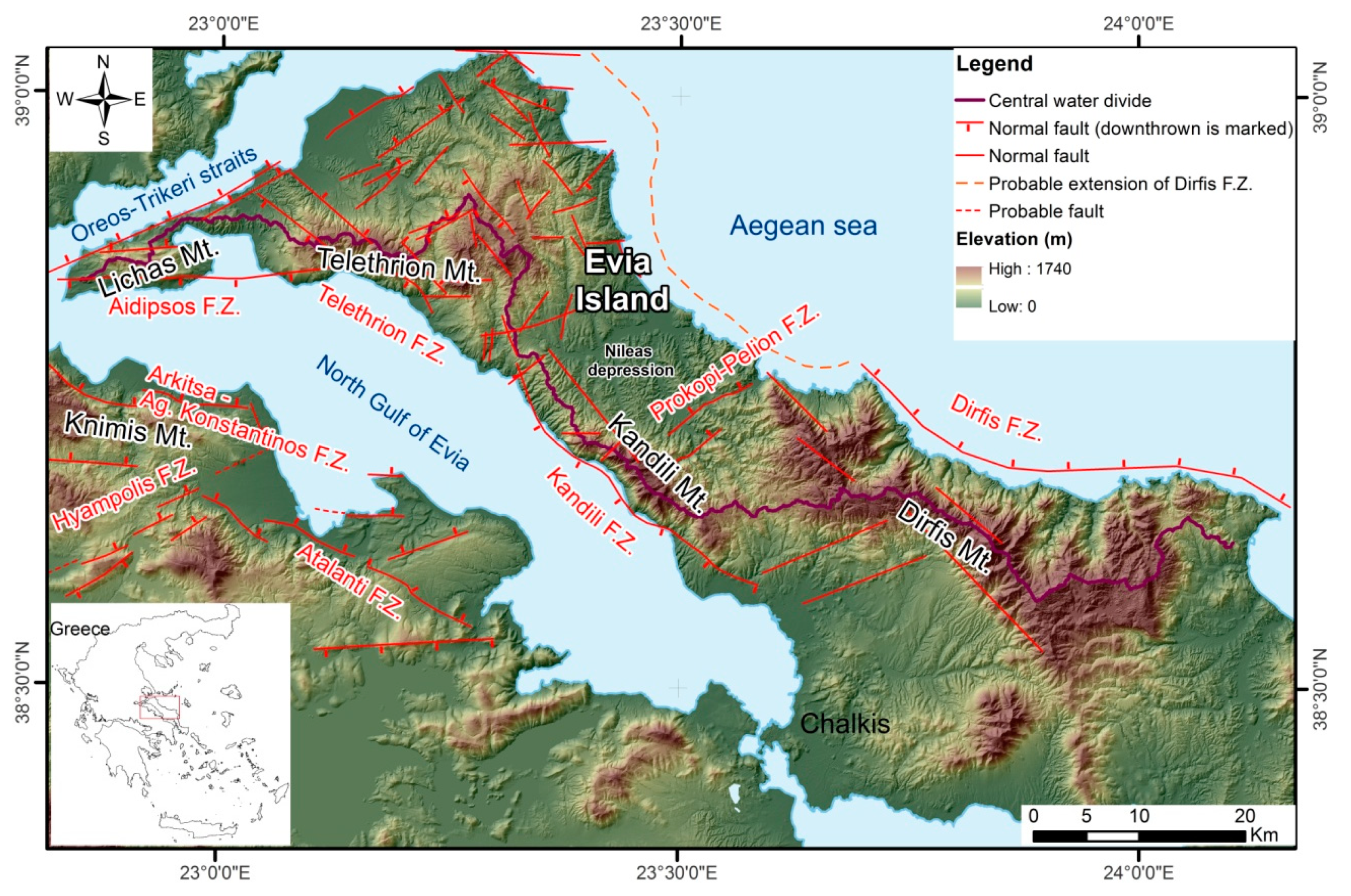
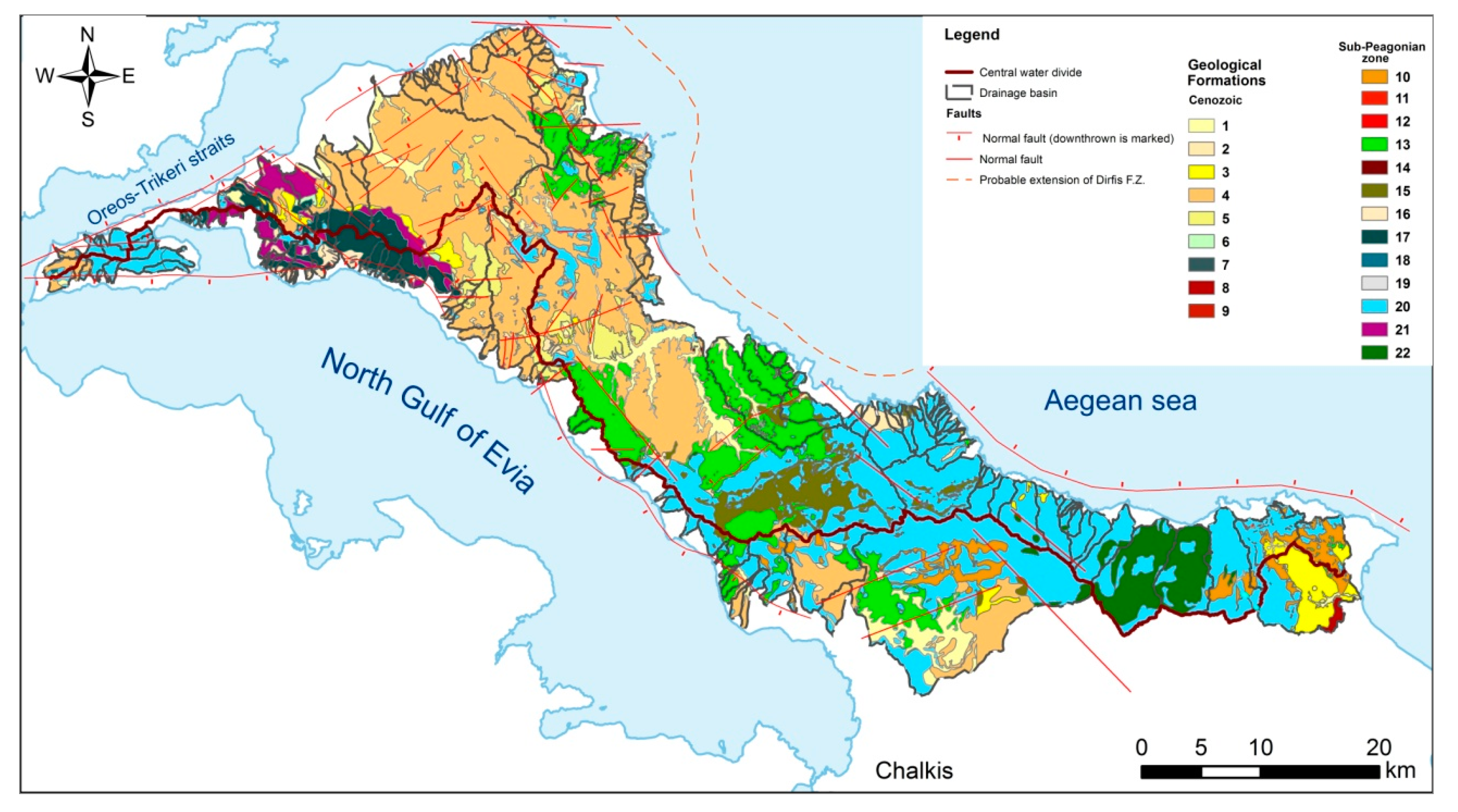
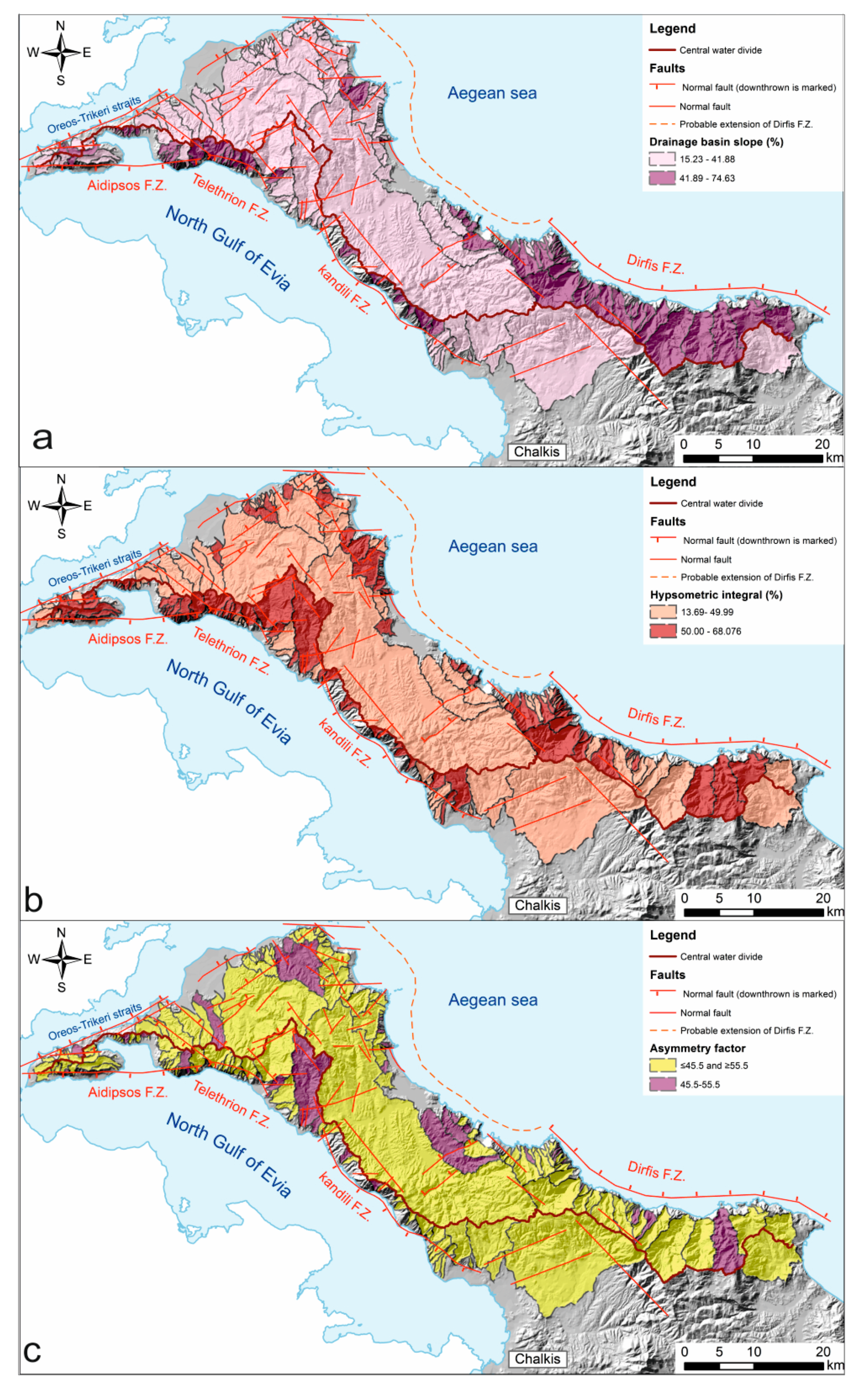
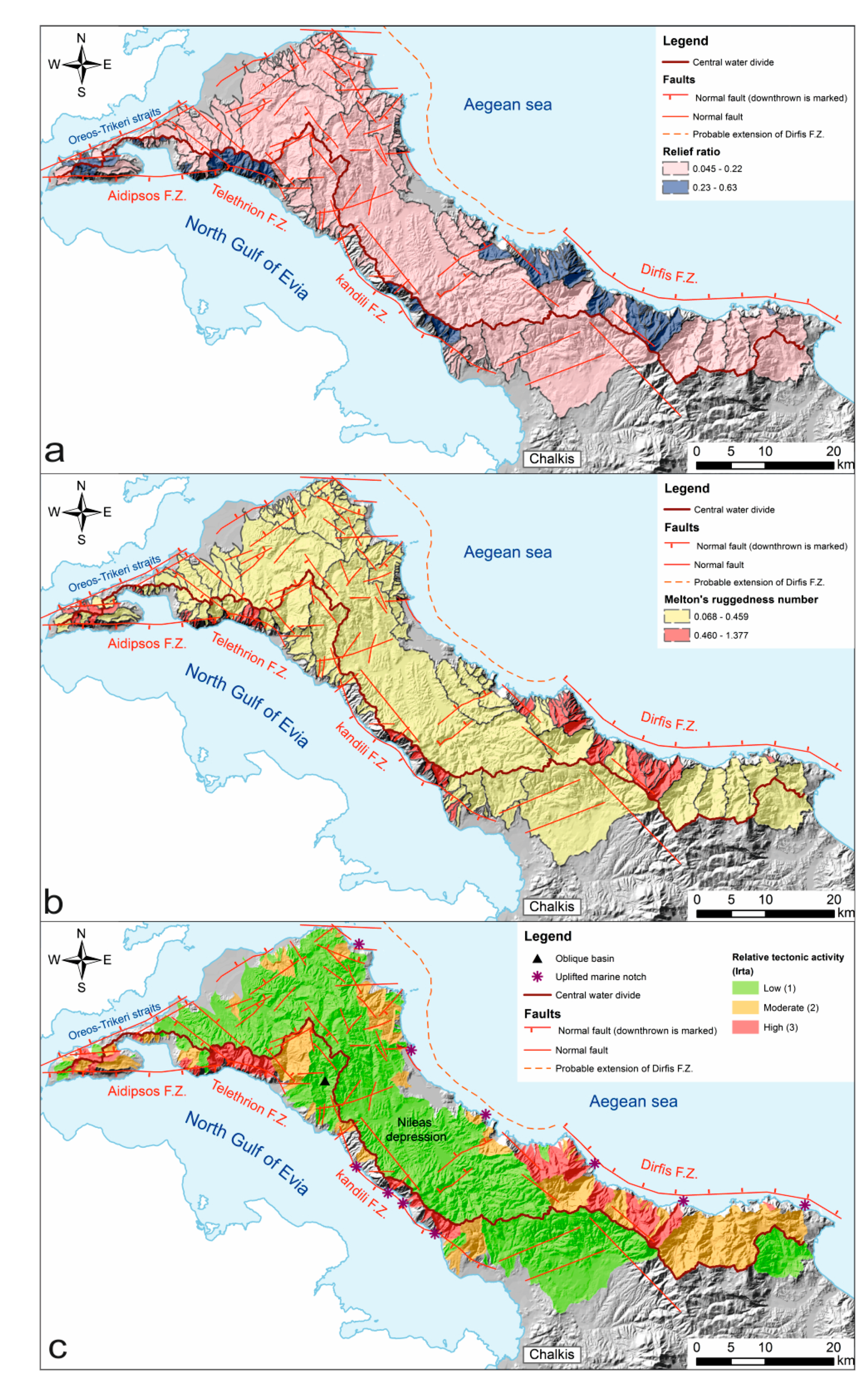
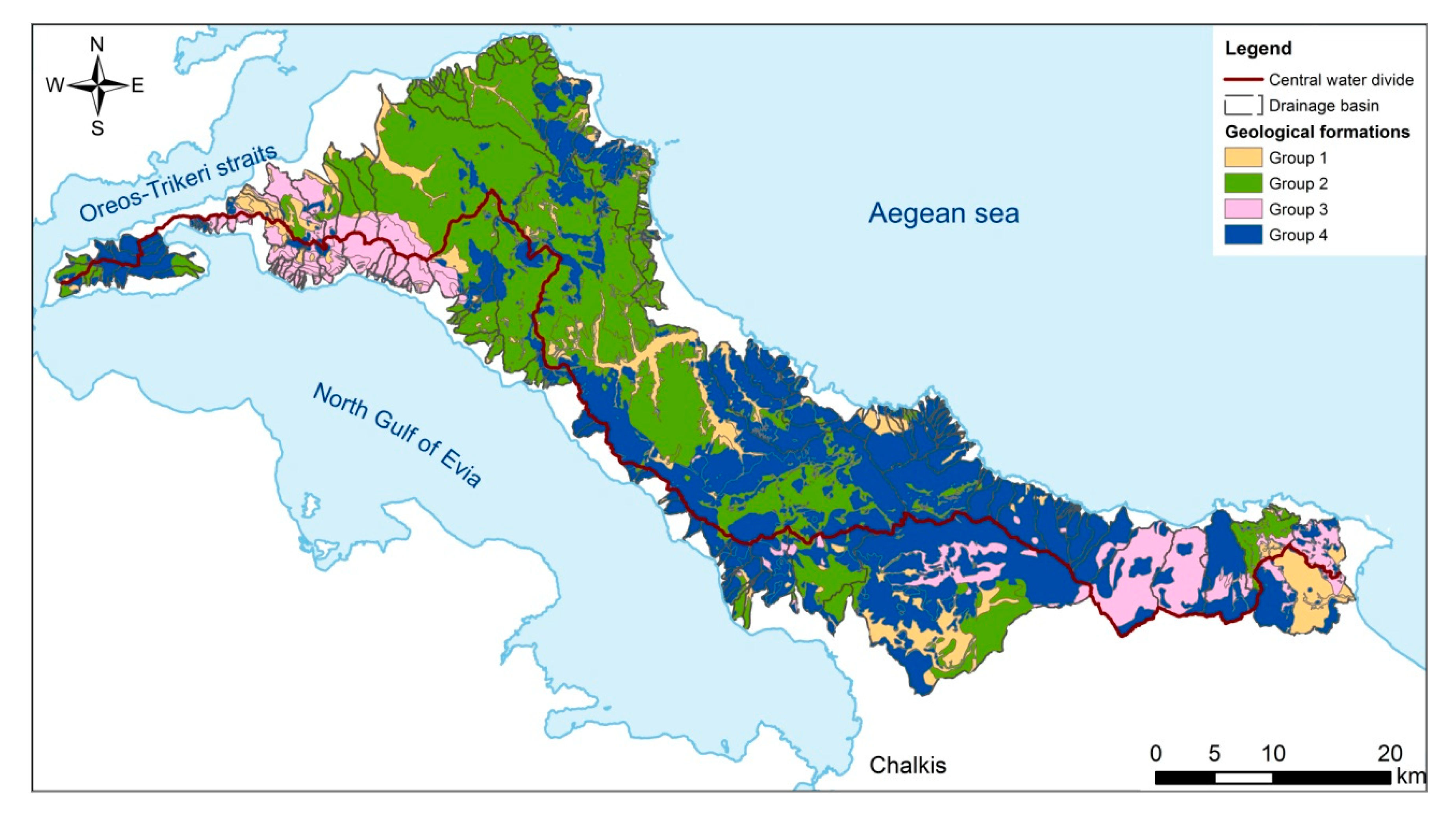
© 2020 by the authors. Licensee MDPI, Basel, Switzerland. This article is an open access article distributed under the terms and conditions of the Creative Commons Attribution (CC BY) license (http://creativecommons.org/licenses/by/4.0/).
Share and Cite
Valkanou, K.; Karymbalis, E.; Papanastassiou, D.; Soldati, M.; Chalkias, C.; Gaki-Papanastassiou, K. Μorphometric Analysis for the Assessment of Relative Tectonic Activity in Evia Island, Greece. Geosciences 2020, 10, 264. https://doi.org/10.3390/geosciences10070264
Valkanou K, Karymbalis E, Papanastassiou D, Soldati M, Chalkias C, Gaki-Papanastassiou K. Μorphometric Analysis for the Assessment of Relative Tectonic Activity in Evia Island, Greece. Geosciences. 2020; 10(7):264. https://doi.org/10.3390/geosciences10070264
Chicago/Turabian StyleValkanou, Kanella, Efthimios Karymbalis, Dimitris Papanastassiou, Mauro Soldati, Christos Chalkias, and Kalliopi Gaki-Papanastassiou. 2020. "Μorphometric Analysis for the Assessment of Relative Tectonic Activity in Evia Island, Greece" Geosciences 10, no. 7: 264. https://doi.org/10.3390/geosciences10070264
APA StyleValkanou, K., Karymbalis, E., Papanastassiou, D., Soldati, M., Chalkias, C., & Gaki-Papanastassiou, K. (2020). Μorphometric Analysis for the Assessment of Relative Tectonic Activity in Evia Island, Greece. Geosciences, 10(7), 264. https://doi.org/10.3390/geosciences10070264







